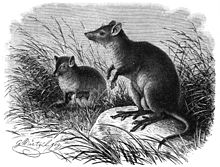Musk rat kangaroo
| Musk rat kangaroo | ||||||||||||
|---|---|---|---|---|---|---|---|---|---|---|---|---|

Musk rat kangaroo ( Hypsiprymnodon moschatus ) |
||||||||||||
| Systematics | ||||||||||||
|
||||||||||||
| Scientific name of the genus | ||||||||||||
| Hypsiprymnodon | ||||||||||||
| Ramsay , 1876 | ||||||||||||
| Scientific name of the species | ||||||||||||
| Hypsiprymnodon moschatus | ||||||||||||
| Ramsay , 1876 |
The musk rat kangaroo ( Hypsiprymnodon moschatus ) is a species of marsupial . It is considered the most primitive representative of the kangaroo-like (Macropodoidea), a taxon that also includes the kangaroos and rat kangaroos .
description
In terms of physique, the musk rat kangaroo shows some features that are not found in any other kangaroo or rat kangaroo. The first toe of the hind legs is still present and the tail is scaled and hairless. The ears are also thin, round and hairless, and the forelimbs are proportionally longer than in the other species. Their short, silky fur is brown or rust-colored, the underside is lighter. These animals reach a head body length of 21 to 34 centimeters, a tail length of 12 to 16 centimeters and a weight of 340 to 680 grams. The name refers to the musky smell that both sexes give off.
Way of life
Musk rat kangaroos live in rain forests along the northeast coast of Queensland ( Australia ). Most of the time, they stay near bodies of water such as rivers or lakes. As the only rat kangaroo they are strictly diurnal; they are considered shy, withdrawn animals. Most of the time they move on all fours instead of jumping, but they can also climb well. With their curled tails they collect branches and leaves from which they build a nest. They usually live solitary, but sometimes go in pairs or threes in search of food.
The musk rat kangaroo also differs from other rat kangaroos in terms of food, as it feeds almost exclusively on insects . Occasionally it also ingests worms, mushrooms and berries, with the animal often sitting on its rear end and digging through the leaves on the ground for prey with its front paws.
Reproduction
Females have a well-developed pouch with four teats. The young, usually two, are born in the rainy season (February to July). They leave the pouch at around five months but remain in their mother's nest for a few more weeks. Sexual maturity occurs at around one year.
threat
Musk rat kangaroos are relatively common and are not endangered species. A large part of their distribution area lies in nature reserves, so that their habitat is largely stable.
Systematics
In the traditional system, the musk rat kangaroo is managed in its own subfamily (Hypsiprymnodontinae) within the rat kangaroos (Potoroidae). From a phylogenetic point of view, however, it is opposed to all other kangaroo species (Macropodoidea), which would make the rat kangaroos a polyphyletic group. For this reason the Hypsiprymnodontinae as Hypsiprymnodontidae have been promoted to the rank of a separate family within the kangaroo-like.
Besides the musky rat-kangaroo is the only extant nature and fossil species Hypsiprymnodon bartholomaii , H. dennisi, H. karenblackae and philcreaseri H. the Hypsiprymnodontiden be assigned to some other fossil forms, including the genera ekaltadeta from the Miocene of Riversleigh and propleopus from the Pliocene and Pleistocene of southeastern Australia, although a more recent relationship analysis (2007) showed that these forms combined as "giant rat kangaroos" ( Propleopinae ) could form their own, even more original line together with other fossil representatives.
literature
- Ronald M. Nowak: Walker's Mammals of the World . Johns Hopkins University Press, 1999 ISBN 0-8018-5789-9
- Wilson, DE, and DM Reeder: Mammal Species of the World . Johns Hopkins University Press, 2005. ISBN 0-8018-8221-4
Web links
- Hypsiprymnodon moschatus in the endangered Red List species the IUCN 2006. Posted by: Australasian Marsupial & Monotreme Specialist Group, 1996. Retrieved on 12 May, 2006.
Individual evidence
- ^ John A. Long, Michael Archer, Timothy Flannery, Suzanne Hand: Prehistoric Mammals of Australia and New Guinea. Johns Hopkins University Press, Baltimore 2003, ISBN 0-8018-7223-5 , pp. 149-154.
- ^ Benjamin P. Kear, Bernard N. Cooke, Michael Archer, Timothy F. Flannery: Implications of a new species of the Oligo-Miocene kangaroo (Marsupialia: Macropodoidea) Nambaroo, from the Riversleigh World Heritage Area, Queensland, Australia. Journal of Paleontology. Vol. 81, No. 6, 2007, pp. 1147–1167, doi: 10.1666 / 04-218.1 (alternative full text access : ResearchGate )

